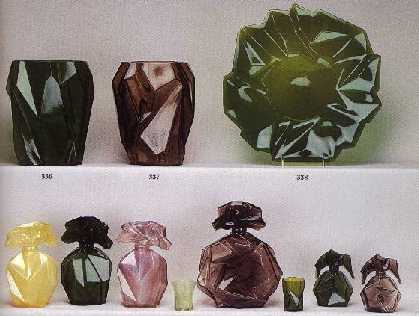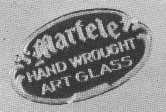by Thomas Jiamachello.
Paris in 1925 was a city alive, bursting with new energy as France regained its vigor as a nation and again became of the centers of art in the Western world. There was new money being made, new literature and art being exhibited, new architecture being designed and built. The time was right for a too long delayed exhibit in the field of decorative arts. That exhibition, which was called l'Exposition Internationale des Arts Decoratifs et Industriels Modernes, truly can be looked at as one of the pivotal events of the 20th century. The term Art Deco, coined in the 1960s by Alaistir Duncan, refers to this Modern Art (Art Moderne).

Above page courtesy of Jack D. Wilson.
In the United States, the predilection for traditional styles dominated the decorative arts. Although Louis Comfort Tiffany had reached back and revived Egyptian and Roman glass shapes, motifs, and treatments with great success, the masses seemed to be comfortably ensconced in the status quo. The extent of this phenomenon can be seen in the reaction when high American officials received an invitation to participate in the 1925 Paris International Exposition of Modern Decorative and Industrial Arts. Saying that there really was nothing new and worthy of exhibit, the U.S. government passed up the chance to be represented at the Fair.
This did not mean that American designers were unaware or unexcited about the Paris Exhibition. In fact, a delegation of New York city based industrial designers attended the fair and were stunned by the originality of work seen there. More importantly, in 1926, a traveling exhibit of some 400 objects, including over 50 pieces of glass had already been in Boston and the Met in New York by April. The exhibit continued to Cleveland, Detroit, St. Louis, Minneapolis, Pittsburgh, and Philadelphia. In the decorative arts field of glassware, the work of Rene Lalique, master glass designer and producer, was well represented in this show. There were "glass vases decorated with large berries, brown scarabs, birds. Glass vases in blue and gray, opal and in violet and opal green."
This traveling exhibition was to have a profound impact on the designer whom I have chosen to highlight in this second installment.
REUBEN HALEY Designer of three of the most extensive lines of "Art Deco" glassware ever to be produced in the United States, Reuben Haley created the Martele, Catalonian, and Ruba Rombic lines for the Consolidated Glass Company's Art Glassware Division from 1926-1933.
Prior to that time, Reuben Haley had spent all his life in the glass industry. Born in 1872, he was in the words of his obituary, taken from a glass industry journal, "one of the best known glass designers in the country...was unquestionably one of the most prolific men in his particular field. Few have given the industry so many original designs as he. He was one of the very few designers in the country who first modeled all their designs in clay; for he was a sculptor as well as a designer and metal worker."
This last mention of the way Haley produced the molds for his designs is the key to understanding the fortuitous combination which was to produce such amazing glassware. A talented designer using the "cast figure mould" process, incredible "color" men who mixed the glass batches and gifted mould makers all combined to produce some of the most original and technically sophisticated glassware of the 20th century.
 It is undeniable that the motifs and glass treatments of Rene Lalique were the main inspiration for the Martele line. This line of glassware is well documented and presented in Jack Wilson's seminal book - Phoenix and Consolidated Art Glass, published in 1989 by Antique Publications. The Martele line offers the best of Lalique's French Art Nouveau motifs, made right here in the good ole U.S of A. It is highly collectible today and has recently started to be seen in some of the better 20th century specialist auction houses in the country. This line of glassware met with commercial and critical success. It was highly popular. It is good testament to the fact that a glass company is a business which must produce what the public will buy.
It is undeniable that the motifs and glass treatments of Rene Lalique were the main inspiration for the Martele line. This line of glassware is well documented and presented in Jack Wilson's seminal book - Phoenix and Consolidated Art Glass, published in 1989 by Antique Publications. The Martele line offers the best of Lalique's French Art Nouveau motifs, made right here in the good ole U.S of A. It is highly collectible today and has recently started to be seen in some of the better 20th century specialist auction houses in the country. This line of glassware met with commercial and critical success. It was highly popular. It is good testament to the fact that a glass company is a business which must produce what the public will buy.
Ah, but the avant garde is alive and well with Reuben Haley! Capitalizing on the recent appearance in the U.S. of the traveling exhibition of the Paris Exposition, in 1928, just three years after the Art Deco aesthetic reached our shores, Reuben Haley designed and the Consolidated Glass Company produced one line of geometric, angular and original glassware which created a stir the minute it was introduced to the American market and that excitement continues unabated today---- Ruba Rombic. Magical words to Art Deco glassware collectors today, this line consisting of 37 items in colors such as "Smoky Topaz", "Jungle Green", "Jade", "Lilac", "Sunshine", and "Silver" remains quintessentially Art Deco.
 It is estimated by members of the Phoenix and Consolidated Collectors Club that there are perhaps only fewer than 3000 pieces of this rare glassware which survive today. The complete line can be seen in Jack Wilson's book in a rare 7 page advertising supplement which is in itself a masterpiece of Art Deco advertising. The play of light and shadow in the ads mirrors that of the glassware itself. Named Ruba Rombic by Consolidated, its name is said to derive from two words. "Rubaiy (meaning epic or poem) and Rombic (meaning irregular in shape)". Consolidated referred to this line as an "Epic in Modern Art."
It is estimated by members of the Phoenix and Consolidated Collectors Club that there are perhaps only fewer than 3000 pieces of this rare glassware which survive today. The complete line can be seen in Jack Wilson's book in a rare 7 page advertising supplement which is in itself a masterpiece of Art Deco advertising. The play of light and shadow in the ads mirrors that of the glassware itself. Named Ruba Rombic by Consolidated, its name is said to derive from two words. "Rubaiy (meaning epic or poem) and Rombic (meaning irregular in shape)". Consolidated referred to this line as an "Epic in Modern Art."
 The reaction of the glass industry can be seen in the following quote: "This is an absolutely cubist creation, and some would call it the craziest thing ever brought out in glassware. The shapes, even to the tumblers, are all twisted and distorted, though at that geometrically correct. The first reaction on viewing it is shock, yet the more the pieces are studied the more they appeal and there comes a realization that with all their distorted appearance they have a balance that is perfect and are true specimens of cubist art."
The reaction of the glass industry can be seen in the following quote: "This is an absolutely cubist creation, and some would call it the craziest thing ever brought out in glassware. The shapes, even to the tumblers, are all twisted and distorted, though at that geometrically correct. The first reaction on viewing it is shock, yet the more the pieces are studied the more they appeal and there comes a realization that with all their distorted appearance they have a balance that is perfect and are true specimens of cubist art."
Such superlatives for the designs of one man! Later, Reuben Haley would create another Art Deco line of glassware, Line 700, which is attracting collectors today. It too can be seen in Wilson's book. Haley's work will live on. I confidently predict that he will be regarded as one of the most important American glass designers of the 20th century.
Can Consolidated's creations be found on the market today? With a little searching, it is possible to build a collection of this historically important American glassware. Have a deep pocket! Ruba Rombic commands premium prices as it has already attracted the attention of major U.S. museums and. Once found primarily in the booths of depression glass dealers, it has "come out of the closet" and risen stratospherically.
Let's consider 5 pieces of this glass from the Ruba Rombic line and their comparative prices in 1989 when the book was published and now in 2008. (Current prices derived from Florence's Elegant Glassware of the Depression Era, p. 182-183).
We will compare the small perfume bottle, the 8 1/4" pitcher, the 10" plate, whiskey tumbler, and the 9" vase.
| ITEM & COLOR | 1989 VALUES | 1995 VALUES |
|---|---|---|
| perfume bottle, jungle green | $250.00 | $1,200.00 |
| pitcher, sunshine yel (cased) | $500.00 | $3,000.00 |
| 10" plate, jade (cased) | $150.00 | $500.00 |
| whiskey tumbler, jade (cased) | $30.00 | $450.00 |
| 9.5" vase, smoky topaz | $350.00 | $2,000.00 |
As is the general rule of thumb in most collecting areas in the 20th century area, rarity and condition are primordial criteria. The serving pieces and accessory pieces in this Reuben Haley designed line will always increase at a higher rate than the more common plates and small tumblers. There is no doubt that items which today are difficult to locate in excellent condition will become all the more valuable as we reach the 21st century. Being blown glassware, Ruba Rombic in mint condition is exceedingly rare. Collectors have resigned themselves to small nicks as a matter of course. A mint piece of Ruba is a prize indeed!
Thomas A. Jiamachello